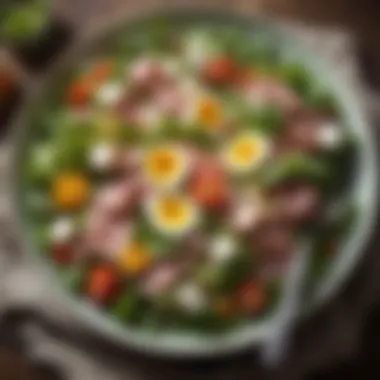Complementary Sides for Easter Ham: A Detailed Guide


Intro
Easter is a time for family gatherings and celebratory meals, where ham often takes center stage. The sweetness and saltiness of ham create a flavorful base, but complementary sides can enhance the dining experience. Finding the right side dishes for your Easter ham can create a harmonious balance on your table. This guide will dissect various options available, from classic to modern sides, ensuring there is something for every palate.
As you plan your festive feast, consider the textures and flavors that can elevate your spread. Along with traditional sides, explore dietary preferences such as vegetarian or gluten-free options, ensuring inclusivity for all guests. Each section will provide an in-depth look at suitable pairings that can harmonize with the rich profile of Easter ham.
By understanding the elements that make a side dish successful, you can craft a well-rounded meal that does justice to this cherished holiday. Let's begin examining delicious side dishes that perfectly complement your Easter ham.
Prelude to Easter Ham
Easter ham holds a significant place in culinary traditions across various cultures, especially in Western societies. This section provides a foundational understanding of Easter ham within the context of festive meals and celebrations. It examines its historical roots, the cultural symbolism associated with it, and how it has maintained its status as a staple dish during Easter.
Historical Significance
The tradition of serving ham during Easter dates back centuries and resonates with both religious and agricultural practices. The choice of ham often symbolizes the end of winter and the beginning of spring, aligning with themes of rebirth and renewal that are so integral to the Easter holiday. According to historical records, pigs were often prepared for slaughter in the late winter months, ensuring that the meat was perfectly cured by Easter time. This practice arose from the necessity of preserving meat before refrigeration became prevalent. The act of feasting on ham during Easter has thus evolved into a celebration of abundance, making it a centerpiece of many family gatherings and festive meals.
Popularity in Contemporary Celebrations
In modern times, ham is not just a dish; it has become a cultural icon during Easter celebrations. Its popularity can be attributed to various factors. First, the flavor profile of ham—its savory saltiness paired with a slight sweetness—complements a wide range of side dishes, making it versatile and appealing to all palates.
Second, Easter ham is easy to prepare, allowing home cooks of all skill levels to create a memorable meal with relative ease. The convenience of pre-cooked hams further enhances its appeal, as families can focus on sides and desserts rather than spending all day on the main dish. Furthermore, social gatherings have embraced contemporary adaptations of ham, including glazes with pineapples, honey, and even spicy ingredients, catering to modern tastes.
Understanding Flavor Profiles
Understanding flavor profiles is crucial when planning complementary sides for Easter ham. The interplay of various tastes, textures, and aromas can elevate a meal beyond its individual components. Balancing flavors enhances the culinary experience and creates a more satisfying feast. By considering the unique qualities of ham, you can choose sides that not only pair well but also complete the overall dining experience.
Saltiness of Ham
Ham is known for its distinct saltiness, which comes from the curing process. This saltiness can dominate the palate if not balanced with other flavors. Therefore, when selecting side dishes, it's necessary to consider how those flavors interact with the ham. For example, using ingredients that provide a natural counterbalance, such as spices or herbs, can soften the impact of salt. Incorporating fresh herbs in salads or using fruity glazes on vegetables are simple yet effective methods to achieve this goal.
"Pairing is about understanding the primary flavor and finding how best to contrast or complement it."
Indeed, the right balance can elevate the whole dish. Something as simple as a touch of acidity in a vinaigrette or sweetness in roasted vegetables can cut through ham's saltiness and create a harmonious flavor.
Conversely, if all side dishes are salty, it may overwhelm the meal. Being mindful of ingredient choices helps maintain an enjoyable experience.
Sweetness and Acidity Balance
Sweetness and acidity also play significant roles in how a meal tastes. Ham, depending on its preparation, can have varying levels of sweetness from the curing process or glaze. Therefore, when exploring sides, consider the sweetness from glazed carrots or a fruit chutney. These elements can effectively contrast or complement the ham.
Acidity, on the other hand, adds brightness and enhances flavors. Ingredients such as vinegar or citrus can elevate the freshness of the dishes, cutting through the richness of the ham. For instance, a citrusy salad can provide a refreshing break between bites of savory ham. A well-balanced plate should include a mix of sweet, acidic, and savory elements to create depth.
Creating a balance between sweetness and acidity alongside the saltiness of ham leads to a delightful culinary experience. As you plan your Easter meal, think about how each element speaks to the others on the plate. Beautifully orchestrated flavors can leave lasting impressions and encourage appreciation for the craft of cooking.
Traditional Sides to Accompany Ham
Traditional sides play a pivotal role in enhancing the overall experience of an Easter feast centered around ham. These side dishes not only provide a contrast in flavors and textures but also reflect culinary customs passed down through generations. The synergy created between ham and its side dishes can elevate the dining experience, turning a simple meal into a memorable celebration. Nostalgic flavors remind many of family gatherings, making these traditional dishes an essential part of Easter meals.
Classic Potato Dishes


Potatoes are a classic side that pairs well with ham for several reasons. Their versatility allows for a variety of preparations, each offering different textures and flavors. A few notable variations include mashed potatoes, potato salad, and scalloped potatoes.
Mashed Potatoes
Mashed potatoes are quintessential comfort food. Their creamy texture complements the saltiness of the ham beautifully. This dish is popular because most people enjoy its smooth consistency. You can easily add butter or cream to enhance flavor, making it even more indulgent. One unique feature of mashed potatoes is the ability to include other ingredients, like garlic or herbs, to tailor to personal tastes. However, they need to be served fresh to maintain their fluffiness, which can pose a challenge if timing is not managed well.
Potato Salad
Potato salad is another favored traditional side. It lends a refreshing contrast to the savory notes of ham. Its key characteristic is the combination of tender potatoes with crunchy vegetables, often dressed in mayonnaise or vinaigrette. This brings a creamy yet tangy flavor which can help to balance the richness of the ham. One advantage of potato salad is it can be prepared ahead of time and served cold or at room temperature, making it a convenient option. On the downside, some may find it does not pair well with every style of ham, particularly sweeter varieties.
Scalloped Potatoes
Scalloped potatoes offer an elegant alternative with their layered presentation. When baked, the potatoes turn tender while developing a rich, cheesy flavor that complements the ham exceptionally well. The distinctively creamy texture is a major selling point of this dish. It becomes a hearty side that can make the meal feel more indulgent. However, one should note that scalloped potatoes take time to prepare and require careful monitoring during baking to prevent overcooking. Their preparation may limit their appeal to those seeking quicker options for an Easter meal.
Vegetable Options
Incorporating vegetables into the meal not only boosts nutritional value but also adds color and variety to the plate. Green beans almondine, roasted Brussels sprouts, and glazed carrots are three noteworthy choices.
Green Beans Almondine
Green beans almondine stands out for its bright and nutty flavor. This dish typically features green beans sautéed with slivers of almonds, creating a delightful crunch. Its vibrant color adds visual appeal that enhances the presentation of the Easter table. This side is advantageous as it cooks quickly, allowing it to be prepared just before serving. On the downside, it requires fresh ingredients and might not retain its texture if prepared in advance.
Roasted Brussels Sprouts
Roasted Brussels sprouts offer a slightly more modern twist to traditional side dishes. The roasting process caramelizes the sprouts, enhancing their natural sweetness. Pairing nicely with ham, the bitter notes of Brussels sprouts can balance out the sweetness of the glaze often found on the ham. The unique advantage of this side is its ability to develop richer flavors through roasting. However, not everyone enjoys the strong flavor of Brussels sprouts, so it's better to know your audience.
Glazed Carrots
Glazed carrots are another traditional side that brings sweetness to the meal. Their bright orange color and tender texture complement the savory characteristics of the ham. The primary charm of glazed carrots lies in their simple preparation, often requiring nothing more than butter and sugar or honey to enhance their natural sweetness. This dish can appeal to both children and adults alike. However, excessive glazing might overwhelm the natural flavor of carrots, calling for a steady hand in the cooking process.
Contemporary Side Dishes for Ham
Contemporary side dishes for ham play a crucial role in modern Easter celebrations. They provide a refreshing twist on traditional pairings, catering to evolving tastes and dietary needs. Introducing these contemporary choices enhances the overall dining experience, allowing hosts to offer a diverse spread that appeals to various palates. In an age when health consciousness is on the rise, these dishes can contribute important nutritional values and creative flavors to the meal.
Quinoa and Grain-Based Salads
Grain-based salads have gained popularity due to their versatility and health benefits. They often combine robust flavors with easy preparation, making them suitable for festive occasions like Easter.
Quinoa Salad with Cranberries
The quinoa salad with cranberries stands out for its texture and flavor balance. Quinoa is a nutrient-dense grain, rich in protein and fiber. The addition of cranberries adds a hint of sweetness and acidity, enhancing the dish's complexity. This salad is particularly beneficial because it is gluten-free, making it suitable for guests with dietary restrictions. The key characteristic of this dish is its vibrant color, which can bring visual appeal to the table.
A noteworthy feature of quinoa salad with cranberries is its make-ahead convenience. It can be prepared in advance, allowing flavors to meld. This is especially advantageous during festive meals when time management is pivotal. However, one consideration is that quinoa can present a unique texture that not everyone may appreciate.
Faro Salad with Roasted Vegetables
The faro salad with roasted vegetables offers a hearty alternative to lighter salads. Whole grains like faro provide a chewy, nutty flavor that pairs well with the caramelized sweetness of roasted vegetables. This salad is an excellent way to include seasonal produce on your Easter table. A significant aspect is its adaptability; various vegetables can be used based on availability and preference, which adds to its allure.


One distinct feature of this salad is its potential to retain texture when served warm or cold. This makes it a flexible side dish for both preparation and serving. However, it may require more time to prepare than other quick-prep salads, as roasting vegetables can be time-consuming.
Creative Slaw Variations
Slaws have evolved significantly, shifting from typical cabbage mixtures to innovative combinations that surprise the palate. Incorporating slaw variations can elevate the meal and complement the rich flavors of ham beautifully.
Asian Slaw
The Asian slaw brings an exciting blend of flavors and textures to the table. Usually made with cabbage, carrots, and a variety of crunchy vegetables, it often incorporates a sesame or peanut dressing. The key characteristic of this slaw is its balance of sweetness, tang, and crunch, providing a refreshing contrast to the saltiness of ham.
A unique feature of Asian slaw is its colorful presentation. Bright colors not only make the dish appealing but also signal nutritional diversity. It is easy to prepare and can often be made in bulk, making it a popular choice for gatherings. One possible disadvantage, however, is the potential for the dressing to make the slaw soggy if prepared too far in advance.
Apple and Cabbage Slaw
The apple and cabbage slaw highlights the sweet and tart flavor of apples, combined with the crunch of cabbage. This dish is particularly beneficial as it offers a balance of sweetness from apples and the savory depth of the cabbage. Its appeal lies in its ability to pair well with the savory flavors of the ham while providing a refreshing taste.
An important feature of apple and cabbage slaw is its seasonal relevance, making it suitable for spring celebrations. It requires only simple ingredients, making it easy to prepare. However, one consideration is that the balance of sweet and savory can vary widely depending on the type of apples used.
Serving Considerations
Serving considerations are crucial when it comes to creating a harmonious meal to accompany Easter ham. This section delves into the intricacies of presentation and timing of side dishes, which together can greatly enhance the dining experience. Effective serving not only impresses guests but also ensures that all dishes complement each other in taste and visual appeal. Proper attention to these areas can make or break the enjoyment of a meal, especially during a special occasion like Easter.
Presentation Techniques
Color Contrast
Color contrast in a meal is essential for aesthetics. It involves pairing dishes with varying colors to create an appealing look on the plate. This is particularly relevant in Easter celebrations, where visual presentation reflects the festive nature of the occasion. A plate that includes bright greens from vegetables alongside the pinkish hue of ham can evoke a more inviting and appetizing display.
The key characteristic of color contrast is that it not only makes the meal look more attractive but also showcases the variety of flavors offered. Selecting dishes with distinct colors, such as vibrant greens and golden yellows, can enhance the overall appeal. However, a drawback may include the challenge of ensuring that all contrasting colors also work well together in taste.
Plate Composition
Plate composition refers to how food is arranged on the plate. This is an important aspect because a well-composed plate can draw attention to each element without overcrowding. In this article, good plate composition is vital for balancing the visual elements of the meal.
One key characteristic of effective plate composition is variety in height and shape, which contributes to a dynamic appearance. For instance, creating height with a mound of mashed potatoes next to neatly sliced ham creates intrigue. Conversely, poor plate composition can lead to a chaotic appearance, making it difficult for diners to appreciate individual components of the meal. This can detract from the overall dining experience, especially during an important holiday.
Timing for Side Dishes
Preparing Ahead vs. Last Minute
The timing of when to prepare side dishes can significantly influence the quality of the meal served. Preparing dishes ahead of time allows for a more relaxed cooking experience. It also provides an opportunity to focus on the main attraction: the ham. Preparing ahead ensures that all sides are ready, reducing stress on the day.
One key advantage is the ability to let flavors meld, particularly in dishes like salads or stews. However, some might argue that certain sides, like roasted vegetables, are best when made last minute to preserve freshness. This balance is crucial, and understanding when to prepare specific dishes can enhance meal quality.
Keeping Food Warm
Keeping food warm is another important consideration in the context of a large meal. This is particularly relevant when you have different dishes that need to be served at their optimal temperature. Maintaining the ideal temperature ensures that each dish is enjoyable and enhances the overall dining experience.


A practical tip includes using warming trays or foil to keep dishes at the proper temperature while waiting to be served. An advantage of ensuring all sides remain warm is that it enhances the flavors and cohesiveness of the meal. On the other hand, prolonged exposure to heat can lead to overcooked sides, which can detract from the intended texture and taste.
Dietary Considerations
Understanding dietary considerations is essential when planning a meal centered around Easter ham. Many people today have specific dietary requirements or preferences due to health reasons, ethical beliefs, or lifestyle choices. Addressing these considerations not only ensures everyone at the table can enjoy the meal but also adds variety and creativity to the dining experience.
The focus here will be on gluten-free options and vegetarian alternatives, which are two significant categories that cater to diverse needs. By providing alternatives that are both delicious and satisfying, hosts can create an inclusive atmosphere for their guests.
Gluten-Free Options
Substituting Ingredients
Substituting ingredients for gluten-free diets is a key practice for those avoiding gluten due to conditions like celiac disease or gluten sensitivity. Utilizing gluten-free flours, such as almond or coconut flour, allows for the creation of tasty side dishes without sacrificing flavor. Additionally, many grains like quinoa and rice are naturally gluten-free, making them excellent choices for side dishes.
This approach is beneficial in this guide because it provides options that feel substantial without the gluten. A unique feature of substituting ingredients is that it often encourages creativity in the kitchen, as cooks experiment with new textures and flavors. However, care should be taken to ensure that substitutes work in the recipes chosen, as not all gluten-free options behave like traditional ingredients in cooking and baking.
Recipe Examples
Incorporating gluten-free recipe examples helps clarify how these substitutions can manifest in real dishes. For instance, a quinoa salad mixed with fresh vegetables and a zesty lemon dressing serves as a light yet filling complement to ham. Similarly, roasted sweet potatoes mashed with garlic and herbs can be both comforting and gluten-free.
These recipes highlight a key characteristic: they provide a balance between nourishment and flavor. The unique feature of these examples is their accessibility to both those who require gluten-free options and those seeking to try new tastes. An advantage of these dishes is that they can often be prepared in advance, which alleviates stress on the day of serving. Yet, one disadvantage may be the need for careful ingredient checks to avoid cross-contamination.
Vegetarian Alternatives
Plant-Based Sides
Plant-based sides offer a wholesome alternative to traditional meat accompaniments. Dishes like roasted cauliflower or stuffed bell peppers can serve as robust complements to an Easter ham. Incorporating plant-based options supports guests who may be vegetarian or simply interested in increasing their vegetable intake.
A notable characteristic of plant-based sides is their ability to be both nutritious and satisfying. For instance, a hearty chickpea salad packed with spices not only provides protein but also adds vibrant flavors to the meal. These dishes can enhance the dining experience by promoting variety. The disadvantage might be that some guests expect meat-based sides, so there is a slight risk that these options may not meet everyone's satisfaction.
Creative Vegetable Dishes
Creative vegetable dishes can elevate a traditional Easter meal. Things like roasted vegetable medleys with a drizzle of balsamic glaze or a colorful beet and goat cheese salad add an aesthetic appeal.
These dishes possess a key characteristic: they can be stunning on a plate. The unique feature is their versatility in flavor combinations and presentation styles. An advantage is that they can often include seasonal produce, making them a fresh addition to the table. However, it requires careful planning to ensure all vegetables cook well together, highlighting the importance of understanding cooking times.
Providing a range of dietary options not only respects guests’ preferences but also enhances the overall meal experience, making it more memorable for all.
Culmination
In this guide, we explored the various dimensions of pairing sides with Easter ham, emphasizing its significance regarding enhancing the festive meal. The choice of complementary dishes plays a crucial role in creating a balanced dining experience. Not only do sides contribute to the overall flavor profile, but they also add texture and color to the plate, creating a feast for both the palate and the eyes.
Recap of Important Points
Key takeaways from our exploration of sides for ham include:
- Balanced Flavors: Remember to balance the saltiness of the ham with sweetness and acidity from sides like glazed carrots or fruit chutneys.
- Diverse Options: A variety of traditional and contemporary sides ensures that all guests have something enjoyable to eat. Options range from classic mashed potatoes to innovative quinoa salads.
- Dietary Needs: Acknowledging gluten-free and vegetarian options can accommodate various dietary preferences, making it easier to host a diverse group of diners.
- Preparation Timing: Planning when to prepare each dish is essential for a smooth serving experience. Some sides can be made ahead, while others can be made fresh, ensuring everything is warm and ready.
Final Thoughts on Pairing Sides with Ham
Pairing sides with Easter ham is not just about filling the plate; it is a careful consideration of flavors, textures, and dietary preferences. While traditional sides have a lasting charm, integrating modern dishes can elevate the meal to new heights. The dynamics of food pairing should always reflect personal taste while respecting the ingredients involved.
A thoughtful approach to side dish selection can transform a simple ham dinner into a memorable feast, catering to all tastes and occasions.
In summary, with a little creativity and awareness of your guests’ needs, you can create a memorable meal that resonates with everyone present.







